Heritage plays a temporal trick – it can make history feel within reach. I walked up the pathway leading to Lahori Gate, entrance to Red Fort, where friends waited. On my right was the eyesore barbican built by Aurangzeb; Shah Jahan, his father, who built the fort, was miffed with the looming gorgon in garish orange. ‘You have made the fort a bride,’ he wrote from his house arrest quarter overlooking the Taj Mahal in Agra, ‘and set a veil on it.’ The high wall today, fortunately, blocks the view of the jammed road and pavements choc-a-bloc with ice-cream and lemonade sellers, auto and cycle rickshaws. The cacophony wafts over it like how the rabble of vendors would have from the traditional bazaars that usually fringes regal edifices.
Khushwant Singh’s ‘erotic and irreverent magnum opus’ Delhi had made the Red Fort come alive for me like never before. It had the hijda Bhagmati, Singh’s mistress, who stayed in Lal Kuan nearby, a red-light area. My attempt once to follow her from Tihar jail, where she was lodged, through the Ridge area where Singh found her unconscious and tracing some of their little sojourns together around the city had to be aborted due to a sputtering motorcycle on a Sunday morning. I hope to do it someday. It also had the octogenarian Bahadur Shah Zafar, the last emperor of India, indulging in an occasional venery fortified by ministrations of a trusted hakim, stoically coming to terms with peripeteia before being exiled to Burma.
The last emperor makes his entry griping helplessly about how the ongoing Ramadan fast has made him unable to savour succulent mangoes.
And that year the holy month of fasting fell during the mango season. The best time to enjoy mangoes is mid-morning and afternoon. This was forbidden.
Though later he has sex with his young queen Zeenat after she convinces him of exigency clauses that permitted pleasure – ‘the shariat providing for dispensation in times of stress.’
It was a time of great stress: the 1857 mutiny had just begun. Indian sepoys rebelled against their white masters in Meerut, killed many of them and reached Delhi where they killed many more. They aimed vainly to crown Bahadur Shah Zafar the emperor of India.
‘His nom de plume was Zafar which meant ‘victory,’ though victory eluded him,’ writes Rana Safvi in the introduction to her translation Dastan-e-Ghadar, The tale of a mutiny. The book itself is a memoir in Urdu by Zahir Dehlvi, a young official in Bahadur Shah’s court during the revolt. Safvi, as she told me later, took a year to complete the work during which she spent a lot of time in the Fort reliving the era. Her unrivalled knowledge and warm geniality makes her heritage walks enlightening and delightful. Safvi waited with the rest of my friends near the ticket counter from which a weekend queue snaked. Thankfully, my ticket had already been purchased (Rs 35).
We entered the Red Fort through the three-storied Lahori Gate, with its arched, square and rectangular panels embellishing the grandeur. It is flanked by octagonal towers and open pavilions. Seven marble domes stand atop in curious contrast against the red of sandstone. Flame-shaped battlements extend towards both sides of the Gate. The columns are vertiginous and I felt heady walking in. It was easy to imagine how it would have felt entering these gates riding astride your favourite elephant, to water-cooled gardens, halls of audience, harems, eunuchs, hammams and private mosque, to the place you call home. But during the Ramadan month the emperor was consumed more by his privations.
As the canon roared over the Lahori Gate to proclaim the beginning of the fast, our hookah-bearer removed the pipe from our presence.
Serried archways with numbered shops selling tourist bric-a-brac opened to a well-tended garden, a typical fort feature from the days of Babur. The Diwan-e-Aam or the ‘hall of public audience’ is where the emperor met his subjects. The hall is on a raised platform and flaunts an impressive front of nine engraved arches. The Naubat Khana announced the arrival of the emperor and that of other dignitaries. A typical feature of rich households, it played music through most part of the day. Safvi told us that the rich floral designs on its sandstone façade was once upon a time painted in gold. Those days of glory are long gone – even before the British retook Delhi razing to rubble large parts of the Red Fort following the 1857 uprising, it was looted by the Persian marauder Nadir Shah.
The Rang Mahal where we stood now is one of the few structures that has survived repeated onslaughts. This was the royal harem. Once a large pool stood inside the Mahal inlaid with precious stones giving it different colours, thus the name ‘Rang’ meaning ‘colour.’ A stairway that led to subterranean chambers had been cordoned off – it looked like the courtesans were fated to seclusion even in afterlife. The harem was closest to the Diwan-e-Khas, Shah’s private quarters. Like the hall of public audience, this too is on an elevated platform featuring a façade with nine arches, marbled flooring and low windows that opened to the river.
Of late it had been our habit to rise a watch before sunrise and sit on the balcony overlooking the river… We used these hours for contemplation. We liked to sit wrapped in darkness and in silence; we liked to watch the light of the waning moon reflected in the Jamna…
Where the Jamna (Yamuna) once coursed I spotted busy traffic, the river had receded by several hundred yards over the centuries. Trees stood as if in tribute to these once fertile plains. To the north of the Diwan-e-Khas is the famous hammam which again was shut off to public. (Somebody from our group had pointed out that Rs 35 was too less an admittance fee with so much grandeur lying around. I too agreed with it. But changed my mind when I found half of them were inaccessible.) The hammam, apparently, consists of three spacious sections separated by corridors: there were changing rooms, bathing areas for children, fountains with scented water and sauna. The Moti Masjid or ‘pearl mosque’ is to the west of the hammam. Somewhere in Delhi, Bahadur Shah is tearing up at his inability to keep up with the opulence of his forebears. You feel the same looking at the state of Moti Masjid.
After these hours of solitude, we repaired to Moti Masjid built by our illustrious ancestor, Alamgir Aurangzeb (may Allah rest his soul in paradise).
The monsoon brought with it a lull in the rebellion which itself did not last for more than a few months. It also marked the arrival of Bakht Khan as the new commander-in-chief of the rebel forces. Bakht Khan took over the reins from an ineffective, some even say asinico, Mirza Mughal who was the emperor’s son. This brought not just a lease of hope but also some respite for the Shah who promptly made up for all his ordeals during the fast.
We spent our days in the monsoon pavilions, Sawan-Bhadon, that we raised in Hayat Baksh Garden. Between these two pavilions was a large reservoir in the centre of which was another stone pavilion which looked like it was afloat on the water. We had a small boat to take our guests to it. Or subjects named it after us, Zafar Mahal. Here we used to hold symposia of poets, entertained our friends with song and dance. That year we organised a small mushaira in honour of Taj Mahal Begum, younger sister of Zeenat, whom she had persuaded to join our harem. With Zeenat’s consent, we did honour to her virgin sister and had her share our couch for several nights.


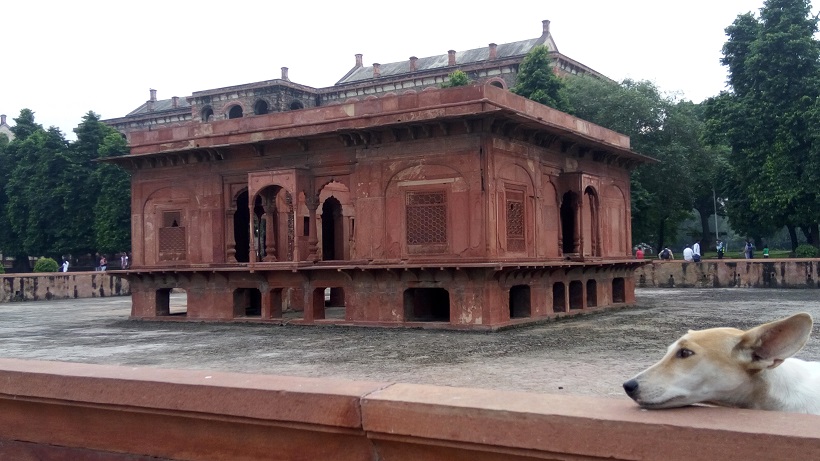
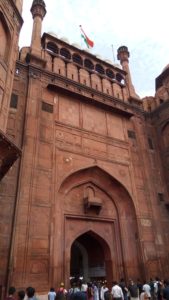
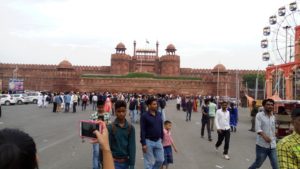
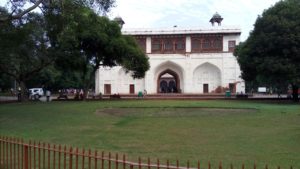
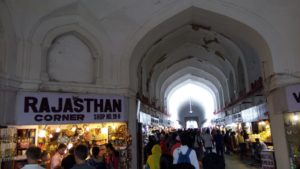
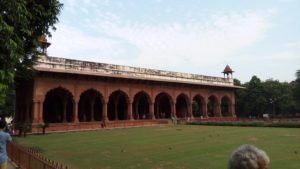
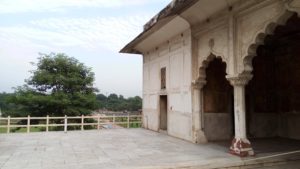
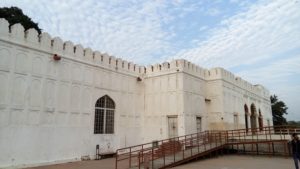
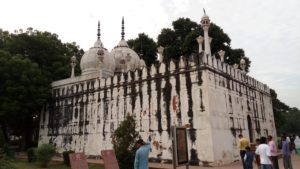
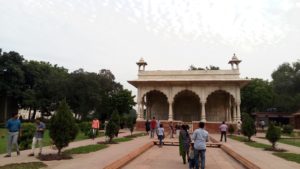
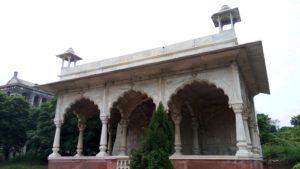
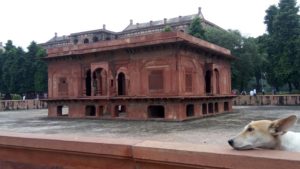









What a life it must have been. And yes with the Yamuna flowing in full swing…
Fabulous. The forts of India are my favourite part, well apart from the food 🙂 I do believe I learned more about English history while travelling India than I did in school!
Thank you, Sarah.
This is great! The quality of writing coupled with a great choice of topic and some amazing photographs is what makes this article awesome. Kudos! 🙂
Also, visit http://www.wheelstreet.com to rent all your favorite bikes at the most affordable prices.
Thank you. But they don’t allow bikes inside the fort! 🙂
I haven’t visited India in my life but now after reading this will definitely visit India once to see all these beautiful and historical monuments.